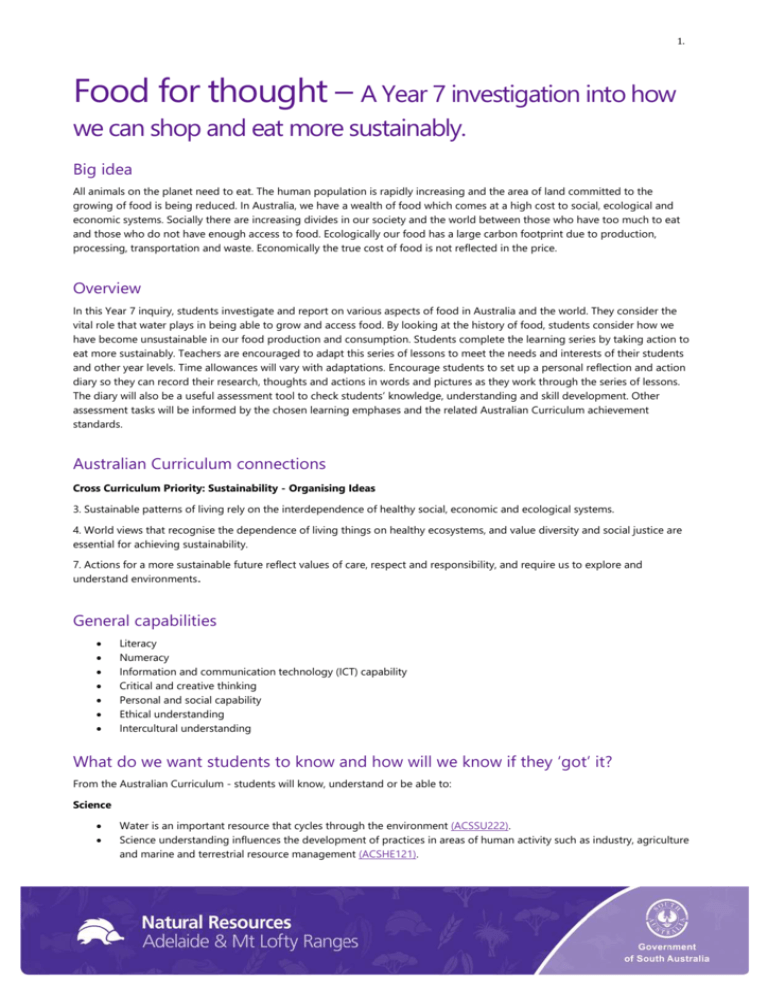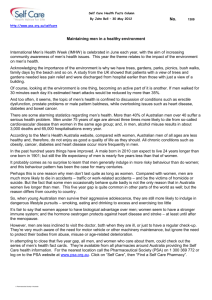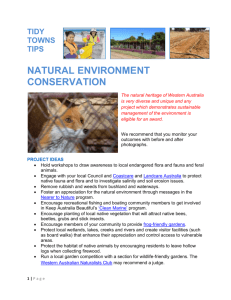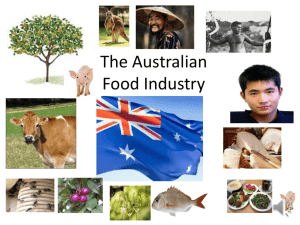Food for thought - naturalresources.sa.gov.au
advertisement

1.
Food for thought – A Year 7 investigation into how
we can shop and eat more sustainably.
Big idea
All animals on the planet need to eat. The human population is rapidly increasing and the area of land committed to the
growing of food is being reduced. In Australia, we have a wealth of food which comes at a high cost to social, ecological and
economic systems. Socially there are increasing divides in our society and the world between those who have too much to eat
and those who do not have enough access to food. Ecologically our food has a large carbon footprint due to production,
processing, transportation and waste. Economically the true cost of food is not reflected in the price.
Overview
In this Year 7 inquiry, students investigate and report on various aspects of food in Australia and the world. They consider the
vital role that water plays in being able to grow and access food. By looking at the history of food, students consider how we
have become unsustainable in our food production and consumption. Students complete the learning series by taking action to
eat more sustainably. Teachers are encouraged to adapt this series of lessons to meet the needs and interests of their students
and other year levels. Time allowances will vary with adaptations. Encourage students to set up a personal reflection and action
diary so they can record their research, thoughts and actions in words and pictures as they work through the series of lessons.
The diary will also be a useful assessment tool to check students’ knowledge, understanding and skill development. Other
assessment tasks will be informed by the chosen learning emphases and the related Australian Curriculum achievement
standards.
Australian Curriculum connections
Cross Curriculum Priority: Sustainability - Organising Ideas
3. Sustainable patterns of living rely on the interdependence of healthy social, economic and ecological systems.
4. World views that recognise the dependence of living things on healthy ecosystems, and value diversity and social justice are
essential for achieving sustainability.
7. Actions for a more sustainable future reflect values of care, respect and responsibility, and require us to explore and
understand environments.
General capabilities
Literacy
Numeracy
Information and communication technology (ICT) capability
Critical and creative thinking
Personal and social capability
Ethical understanding
Intercultural understanding
What do we want students to know and how will we know if they ‘got’ it?
From the Australian Curriculum - students will know, understand or be able to:
Science
Water is an important resource that cycles through the environment (ACSSU222).
Science understanding influences the development of practices in areas of human activity such as industry, agriculture
and marine and terrestrial resource management (ACSHE121).
2.
Summarise data, from students’ own investigations and secondary sources, and use scientific understanding to identify
relationships and draw conclusions (ACSIS130).
Geography
The nature of water scarcity and ways of overcoming it, including studies drawn from Australia and West Asia and/or
North Africa (ACHGK040).
The influence of social connectedness, community identity and perceptions of crime and safety on the liveability of
places (ACHGK046).
The physical features of ancient Egypt, Greece or Rome and how they influenced the civilisation that developed there
(ACDSEH002,ACDSEH003, ACDSEH004).
Present findings, arguments and ideas in a range of communication forms selected to suit a particular audience and
purpose; using geographical terminology and digital technologies as appropriate (ACHGS053).
English
Identify and explore ideas and viewpoints about events, issues and characters represented in texts drawn from
different historical, social and cultural contexts (ACELT1619).
Plan, rehearse and deliver presentations, selecting and sequencing appropriate content and multimodal elements to
promote a point of view or enable a new way of seeing (ACELY1720).
History
Develop their understanding of the physical features of Egypt, (Greece, or Rome) and how they influenced the
civilisation that developed there (ACDSEH002).
How do we get students there?
1.
Ask students to write lists of the foods they have eaten in the last two days. Group the foods into food groups on a
food pyramid. Ask students to determine if they are eating a healthy balance of foods. Ask if everyone has the same access
to food? Use the World Food Program Hunger Map to research the places in the world with the biggest hunger problems.
Discuss the global challenge of too much or not enough access to food both within Australia and across the world.
Brainstorm the reasons why some people have too much food and others not enough. List the reasons why both cause
problems. Show the presentation Lunch-a-lot and discuss the vast amount of wasted food in Australia. Ask students to
reflect on their diets and how much food they waste. Highlight the important role of water in growing food.
2.
Ask students to brainstorm what makes the places we live in ‘liveable’. One of the ‘liveability’ factors is access to water
resources and food. Research the ancient civilisations of Egypt, Greece or Rome and the physical features that provided
water and food. Discuss the influence of the physical features of the environment on the availability of a variety of food and
the lifestyle of rich people and those living in poverty. Ask students to undertake further research and write a report that
compares the historical research findings with modern-day Australia and consider how well we are managing our water,
agricultural and marine resources. The following websites provide information on water resources:
The State of the Environment for South Australia, 2013
The Murray-Darling Basin: Balancing the priorities of agriculture and the environment – teaching unit
3.
What does food really cost? Watch the video The true cost of food. Teachers are advised to preview the film for suitability
and the best version for the students. The movie is American but the facts are congruent with the Australian situation. List
and discuss the range of costs (social, environmental and economic) and solutions outlined in the movie. Ask students who
have been to a farmer’s market, what they enjoyed and the kinds of produce they found. Compile a survey and email it to
organic growers and sellers in Adelaide asking why and how they grow and sell organic products and any other questions
the students raise. Students could also ask their parents to take them to a farmers’ market or the class could have an
excursion to the organic stalls in the Adelaide Central Market to add information to the survey.
4.
Where does our food come from? Provide groups of students with a wide range of grocery items. Ask them to try to
identify:
3.
Where was the product grown?
Who grew it?
Was it grown organically?
How far has it travelled?
Where was it packaged?
Does it have compostable or bio-degradable packaging?
What does the company claim about their product?
Undertake further research on the product and then summarise the information into social (includes health), cultural,
environmental and economic costs. Each group provides a multimodal report as to how sustainable and ethical the product is
including reasons for their decisions. The products could be listed on a continuum. Encourage them to find more sustainable
and ethical alternatives to the product. Go to Oxfam behind the brands to see comments about some brands.
Example of social (includes health), cultural, environmental and economic costs table.
Social/ Health costs
e.g. too much salt, sugar or
saturated fats
5.
Social/Cultural costs
e.g. cheap/child labour
Environmental costs
e.g. lots of food miles
Economic costs
e.g. packaging and
transportation
How did we eat before supermarkets were created? Ask students to research the history of food collection. How did we
get from hunting and gathering to growing food and then to supermarkets? Draw up a timeline of some of the major steps
in the process. Make a table of the advantages and disadvantages of each stage of the process?
Example of the advantages and disadvantages of some of the major steps in history of food collection.
How we collected food
Hunting
Advantages
Only killed and ate what could manage –
more sustainable
Disadvantages
Had to hunt every day
Went hungry if couldn’t catch anything
Gathering
Growing crops
Keeping animals
Selling excess food
Small shops
Supermarkets
Discuss with students the changes over time and why most Australians have become so affluent that they waste lots of
food. Read them The short and incredibly happy life of Riley by Craig Thompson and Amy Lissiat and discuss the lifestyle of
Riley and the people in the story. Ask students to compare their lifestyle with Riley’s and write their reflections in their
journal.
6.
What can we do as individuals and as a school to live more sustainably? Ask the staff and students for possibilities; e.g.
present findings from research at assembly and ask for ideas. NRM Education staff can provide support if the school
decides to plan and develop a food garden. Grown produce can provide a basis for healthy eating activities. Excess produce
can be sold or given to charities. Research sustainable community groups to see if you can participate in projects related to
eating more sustainably. Look at the school’s canteen list and celebrate the healthy foods and make alternative suggestions
for the unhealthy food. Ask students to identify what they would like to do as individuals.
Oxfam Australia’s Design for Change food waste e-book may provide inspiration for students to make a similar book of
their ideas.
Optional activities
The sustainable food resource from NRM Education.
Write a persuasive text to convince parents to give preference to local and/or more sustainable and ethical foods.
Research an individual food, e.g. bananas or coffee, for their REAL costs.
Choose a favourite two-course meal and work out what ingredients were used, and what the food miles are.
4.
Research and discuss how Aboriginal groups have lived successfully in relationship with their environment for tens of
thousands of years.
In groups draw mind maps with 7 billion people on Earth and still growing written in the middle. Ask students to
brainstorm environmental, social, and economic impacts of this and add them to the mind map. Draw the connections
between the impacts to highlight the interconnectedness of the situation.
Further resources
Global education - food security
Students investigate the types and amounts of foods eaten around the world, and the environmental, economic, political and
cultural factors that affect access to food. They develop an understanding of why some people in the world have more than
enough to eat, while others struggle to have the basics for survival, and explore ways people could work together to achieve
food security for all.
The Murray-Darling Basin: Balancing the priorities of agriculture and the environment
This resource provides schools with curriculum lesson plans that focus on sustainable water use in a significant region of
Australia. The Murray-Darling Basin: Balancing the priorities of agriculture and the environment is one of four packages that
provide teachers with lesson plans shaped around a series of investigations that enable students to examine the natural
environment and contemporary issues relevant to that region.
Food: the fundamental right
Caritas Catholic production includes lots of valuable information and case studies about the need for food security in
developing countries. The paper concludes by suggesting ways in which individuals can participate in achieving the right to
food.
World Food Day, Food and Agriculture Organisation of the United Nations
Contains resources for understanding the current global situation re food and food security.
Healthy people depend on healthy food systems Click here to view the issues paper
World Vision: poverty and hunger
The education resources created for this topic are designed to develop students’ understanding of poverty and global
hunger, with a focus on Timor-Leste (East Timor). The activities can stand alone, and do not need to be taught together.
Pop-up Foundation
The Pop-up Foundation was established to create the conditions that enable sustainability projects to flourish. They work
with schools, communities and businesses. They connect ideas, experience and knowledge of sustainable solutions and help
people to identify and overcome their challenges.
Fairtrade Australia and New Zealand
This resource includes case studies of farmers improving their lives through Fairtrade agreements. Examples include: cocoa,
tea, coffee, sugar.
Adelaide Botanic Gardens
Aboriginal traditional plant use virtual tour
Click here to view the resource.
Adelaide Botanic Gardens
Tomato tales blog
Click here to view the resource
New South Wales Environment Protection Authority Love Food Hate Waste tips: includes factual resources designed to
assist in raising awareness of food waste in NSW.
Oxfam Australia
Grow campaign
Click here to view the resource.
Oxfam Australia
5.
Food 4 Thought online teaching resource
Click here to view the resource.
Life cycles, where in the world does food come from? Teaching resource
In this Canadian resource kit, there are a number of activities and resources to assist you in guiding students through the web
of the global food system. You will take them on a journey from the realities of a global import-based food system to the
positive alternatives found at a local level.
Community foodies
Is a South Australian nutrition program that aims to build the capacity of communities to make healthier food choices by
training and supporting volunteer community members ('Foodies') to act as agents for change. Click here to view the
resource.
Community Gardens Association
There are now more than 50 community gardens growing around South Australia. The Adelaide Botanic Gardens, with
support from the Australian City Farms and Community Gardens Network, has put together a directory brochure to help find
a garden near you.
Nourish
An educational initiative designed to open a meaningful conversation about food and sustainability, particularly in schools
and communities. Click here to view this resource.
State of the Environment South Australia report. Click here to view this resource.
This resource was developed by the Adelaide and Mount Lofty Ranges Natural Resources Management Board through its
NRM Education program. Your local NRM Education Officer provides support for sustainability initiatives at your school.
These include learning more about sustainability, environmental auditing, and developing biodiversity, nature-play or food
gardens. Click here to view our website.









